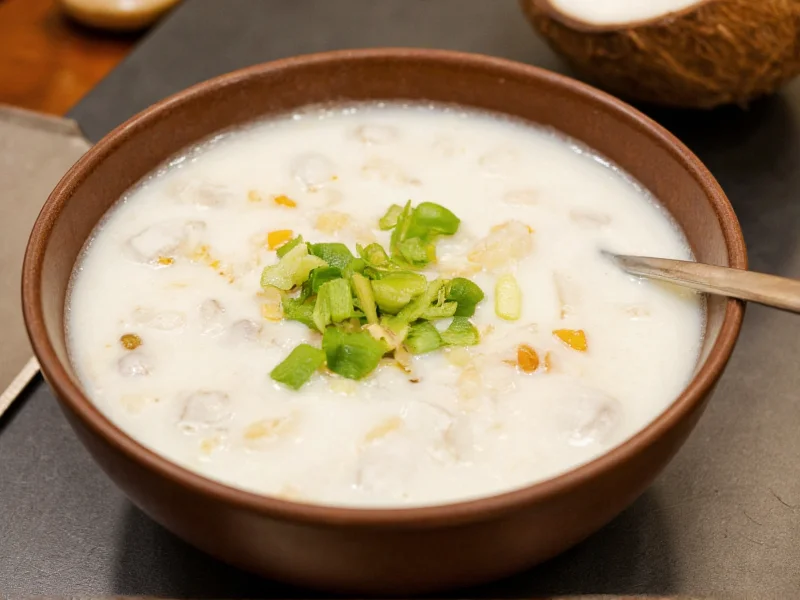For home cooks seeking an authentic yet approachable introduction to Southeast Asian cuisine, coconut milk soup represents an ideal starting point. This versatile dish adapts beautifully to various proteins and vegetables while maintaining its distinctive creamy texture and complex flavor profile. Unlike many Western cream-based soups that rely on dairy, coconut milk soup achieves its luxurious consistency naturally through the emulsification of coconut cream and broth.
The Cultural Roots of Coconut Milk Soup
Coconut milk soup has deep roots across Southeast Asia, where coconut palms grow abundantly. In Thailand, tom kha gai evolved as a medicinal preparation using galangal (a relative of ginger with citrus notes) to aid digestion. Vietnamese canh chua developed in the Mekong Delta region, incorporating local ingredients like tamarind and freshwater fish. Each variation reflects its cultural context while sharing the unifying element of coconut milk as the foundational ingredient.
Essential Ingredients and Their Roles
Creating an authentic coconut milk soup requires understanding how each component contributes to the final dish:
| Ingredient | Function | Substitution Options |
|---|---|---|
| Full-fat coconut milk | Provides creamy base and rich mouthfeel | Lite coconut milk (less creamy), coconut cream diluted with broth |
| Lemongrass | Imparts citrusy aroma and flavor | Lemongrass paste (1 tsp = 1 stalk) |
| Galangal | Adds sharp, pine-like notes (different from ginger) | Ginger (milder flavor profile) |
| Kaffir lime leaves | Contributes floral citrus essence | Lime zest (use sparingly) |
| Fish sauce | Provides umami depth and saltiness | Soy sauce or tamari (for vegetarian) |
Perfecting Your Coconut Milk Soup Technique
The key to preventing coconut milk from separating lies in temperature control. Always bring your broth to a gentle simmer before adding coconut milk, then reduce heat immediately. Never allow the soup to boil vigorously after adding coconut milk, as this causes the fats to separate from the liquid.
For optimal flavor extraction, bruise lemongrass stalks by smashing them with the flat side of a knife before adding to the broth. This releases essential oils without making the soup fibrous. Similarly, tear kaffir lime leaves rather than cutting them to maximize aroma release.
Step-by-Step Preparation Guide
Follow this method for a classic Thai coconut milk soup with chicken (tom kha gai) that serves four:
- Prepare 4 cups of chicken broth by simmering bones with onion and garlic for 30 minutes, then straining
- Add 2 bruised lemongrass stalks, 3 thinly sliced galangal pieces, and 4 torn kaffir lime leaves to the broth
- Simmer gently for 15 minutes to infuse flavors
- Remove aromatics and add 13.5 oz (400ml) full-fat coconut milk
- Add 12 oz (350g) bite-sized chicken pieces and simmer until cooked through (about 8 minutes)
- Stir in 2 tbsp fish sauce, 1-2 Thai chilies (to taste), and 1 tbsp lime juice
- Add 4 oz (120g) mushrooms during the last 5 minutes of cooking
- Garnish with fresh cilantro and additional lime wedges before serving
Common Mistakes to Avoid
Many home cooks encounter issues with coconut milk soup due to preventable errors. Adding coconut milk to boiling liquid causes immediate separation - always reduce heat before incorporating. Overcooking delicate ingredients like shrimp or leafy greens results in rubbery texture. Using canned coconut milk with additives like guar gum creates an unnatural mouthfeel. For the cleanest flavor, choose coconut milk with only coconut and water listed in ingredients.
Variations for Dietary Needs
Coconut milk soup adapts beautifully to various dietary requirements. For vegan preparation, substitute vegetable broth and omit fish sauce (replace with 1 tbsp soy sauce plus 1 tsp mushroom powder for umami). Gluten-free versions require checking fish sauce labels for wheat content or using certified gluten-free alternatives. To reduce calories, use light coconut milk but add 1 tbsp cornstarch slurry to maintain creaminess.
Serving and Storage Recommendations
Serve coconut milk soup immediately for best texture, as the coconut fats may separate upon cooling and reheating. Pair with jasmine rice and Thai basil for an authentic experience. Leftovers keep refrigerated for 3-4 days; when reheating, do so gently over low heat while stirring constantly. Freezing is not recommended as coconut milk tends to separate upon thawing.
Nutritional Profile
A standard serving (1.5 cups) of traditional coconut milk soup contains approximately 280-320 calories, with 22-25g fat (mostly healthy medium-chain triglycerides from coconut), 8-10g protein, and 10-12g carbohydrates. The soup provides significant amounts of manganese, copper, and iron from the coconut milk, plus vitamin C from fresh herbs and lime.











 浙公网安备
33010002000092号
浙公网安备
33010002000092号 浙B2-20120091-4
浙B2-20120091-4